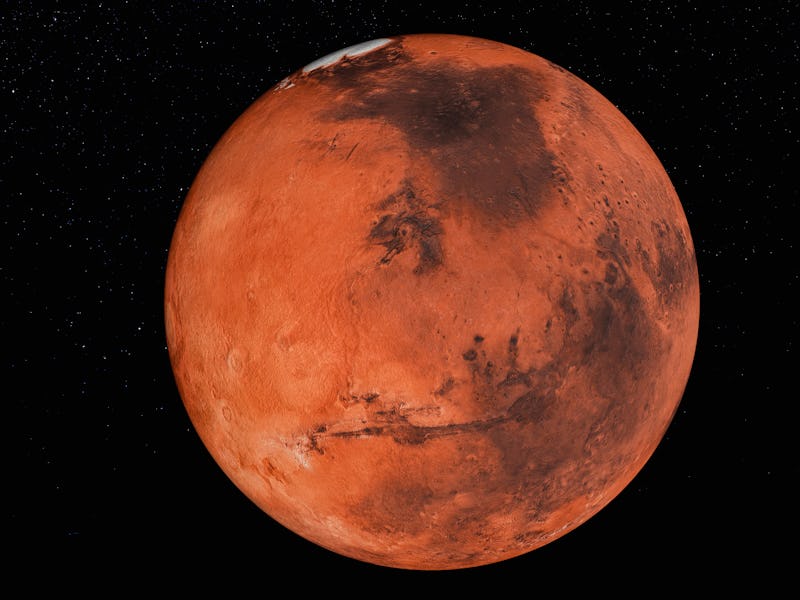Scientists Just Found a Way to Make Living on Mars Easier
Mars is a long way from Earth, making it challenging to communicate with.

Mars is a long way from Earth, making it challenging to communicate with. That tricky communication is becoming ever more important as we launch more and more craft to the Red Planet. It will become absolutely critical when we send actual people there.
So what can be done to increase the speed of communications between our Solar System’s blue and red planets? A paper from researchers primarily based in Spain looks at different networking topologies that could help solve some of the communication problems.
Typically, communication with Mars is done through a system known as the Deep Space Network (DSN). Essentially, it’s a set of giant ground-based communication satellites spread worldwide. Their primary purpose is to communicate directly with every probe launched beyond Earth’s orbit, including those surrounding Mars. Some systems on the ground on Mars also use satellites in orbit around the planet, such as the Mars Reconnaissance Orbiter (MRO), which then broadcasts those signals to the DSN.
Mixed signals
The Mars Reconnaissance Orbiter took this image of the Martian ice cap.
There are several problems with this configuration, including the single point of failure, and size of the equipment needed to send signals back, and the fact that the Sun interrupts communications for a significant chunk of the time. If one of the DSN satellites goes down, or, worse yet, MRO stops operating, communications to most of the scientific equipment on the Red planet could get much dicier. Network engineers on Earth build redundancy paths specifically to avoid this single point of failure problem.
Some signals do lose their strength, even without the presence of an atmosphere in space. So to effectively send high-speed information over long distances, the antennas on this craft have to be massive. Sometimes they exceed the size of the fairing they are launched in, though there are techniques to unpack an antenna in space itself. But an even more significant communication challenge is the Sun.
It might not seem like it, but about 30 percent of the time, Earth cannot communicate with Mars directly. This is mainly because they are on opposite sides of the Sun from one another — or nearly so, anyway. The radiation blasts off of our local star scramble most, if not all, communications, making talking to missions like Spirit and Perseverance near impossible when the planets are thus aligned.
Enter SolarCom
NASA’s first-generation Tracking and Data Relay Satellite was launched in the 1990s.
To get around these problems, Paula Betriu and her colleagues at JPL and the Universitat Politècnica de Catalunya designed a software called SolarCom to analyze the availability, uptime, and speed of different types of network topologies. Two stood out for their significant increase in speed and reliability — a Lagrange point configuration and what they call a “pearl constellation.”
Placing relay satellites at various Lagrange points, primarily the ones between the Sun and the Earth, would seem like a pretty obvious solution. It would significantly reduce interference when the planets are opposite each other in the solar system. It could potentially increase that availability to more than 90 percent — a great increase in capabilities for Mars exploration, but still not as good as a pearl constellation.
That configuration, which mimics a large spherical cloud of satellites in different but complementary orbits, could reach network connection rates of up to 100 percent. However, it could be significantly more expensive as it would require more satellites overall. With launch costs coming down, that might not be as big of a problem in the near future, though.
There are still issues facing increasing the bandwidth to Mars, though, including the networking hardware currently in place on most relay satellites. The Tracking and Data Relay Satellite (TDRS), which is one of NASA’s primary means of relaying information over large distances around the Earth, was initially launched in the 1990s, and even its latest third-generation satellite is already five years old, which is almost a lifetime by networking equipment standards.
All that means is there’s much more work to do before humanity can download crisp real-time videos from Mars. But as a potential crewed mission starts to draw closer, it’s sure to draw more attention to our ability to communicate with, and software packages like SolarCom will help determine the best way to do so.
This article was originally published on Universe Today by Andy Tomaswick. Read the original article here.
This article was originally published on